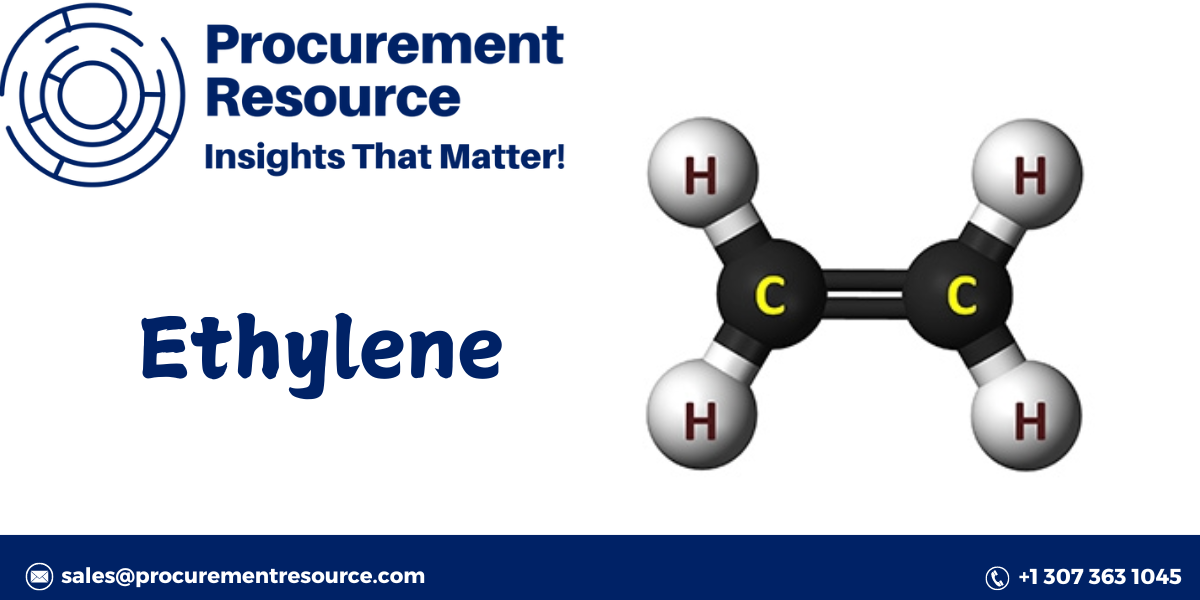The ethylene market is a cornerstone of the petrochemical industry, serving as a key ingredient for a wide range of products, including plastics, synthetic fibers, and antifreeze. The Ethylene Price Trend reflects the intricate dynamics of supply and demand, production costs, and evolving market conditions. In this press release, we will delve into the ethylene price trend, offering comprehensive insights through analysis, recent news, charts, indexes, and graphs that illustrate current and future market scenarios.
Ethylene Trend
The Ethylene Price Trend is shaped by various factors, including the growing demand for ethylene in multiple applications, the cost of raw materials, and geopolitical influences. Ethylene is predominantly used to manufacture polyethylene, which is widely utilized in packaging, construction, and consumer products. The trend indicates a steady rise in demand for ethylene, driven by several key factors:
- Growing Demand for Plastics: Ethylene is the primary feedstock for polyethylene production, which accounts for a significant portion of the plastic market. With rising consumer preferences for lightweight, durable materials, the demand for ethylene is expected to continue its upward trajectory.
- Expansion of End-Use Industries: The ethylene market is bolstered by its applications across various industries, including automotive, construction, and healthcare. The expansion of these sectors, particularly in emerging economies, contributes significantly to the overall demand for ethylene.
- Technological Advancements: Innovations in ethylene production processes, such as enhanced steam cracking technologies and the development of more efficient catalysts, have improved production efficiency and reduced costs, supporting the growth of the Ethylene Price Trend.
- Environmental Regulations: Increasing pressure for sustainable practices has led many companies to invest in greener technologies and alternative feedstocks for ethylene production. Compliance with environmental regulations is reshaping production processes, which could influence prices in the long run.
- Economic Factors: Global economic conditions, particularly crude oil prices and supply chain dynamics, play a crucial role in determining ethylene pricing and availability. The recovery of the global economy post-COVID-19 has resulted in increased industrial activity, further driving demand for ethylene.
Overall, the Ethylene Price Trend is characterized by an interplay of factors that reflect the growing importance of ethylene in various applications and the ongoing developments within the petrochemical industry.
Request For Free Sample: https://www.procurementresource.com/resource-center/ethylene-price-trends/pricerequest
Ethylene Analysis
Analyzing the Ethylene Price Trend involves examining production capacities, pricing dynamics, and regional consumption patterns. Key aspects of the current ethylene market landscape include:
- Production Capacity: Ethylene production is dominated by a select group of major petrochemical companies, with significant production facilities located in regions such as North America, Europe, and the Middle East. The United States is particularly influential, benefiting from its access to inexpensive shale gas resources.
- Pricing Dynamics: Ethylene prices are influenced by various factors, including feedstock costs (natural gas and naphtha), global supply-demand balance, and geopolitical events. Price fluctuations can have substantial downstream impacts, especially in the plastics industry.
- Regional Demand: The Asia-Pacific region is the largest consumer of ethylene, with robust growth driven by the plastics and automotive sectors. North America and Europe also represent significant markets, where demand is supported by ongoing investments in sustainable practices and product innovation.
- Market Trends: Recent trends indicate a growing interest in bio-based ethylene production as companies look to reduce their carbon footprints. The rise of circular economy initiatives focused on recycling and sustainable materials is shaping the future of ethylene production and consumption.
- Regulatory Influences: Government policies and regulations related to emissions and sustainability are increasingly impacting the ethylene market. Companies are adapting their production processes to comply with these regulations, which may lead to higher production costs.
Understanding these factors provides valuable insights into the current Ethylene Price Trend, highlighting opportunities for growth as well as potential challenges that the industry may face.
Ethylene Chart
Charts illustrating the Ethylene Price Trend offer a visual representation of key market data, including pricing, production capacity, and demand distribution. Important elements often reflected in ethylene charts include:
- Price Movements Over Time: Historical price charts for ethylene show how pricing has changed in response to fluctuations in feedstock costs, supply-demand dynamics, and market conditions. These trends help stakeholders anticipate future pricing patterns.
- Regional Demand Breakdown: Charts illustrating ethylene consumption by region highlight significant markets, with Asia-Pacific as the dominant consumer. Understanding regional variations is essential for companies looking to identify growth opportunities and tailor their strategies.
- Production Capacity by Region: A chart displaying ethylene production capacities across different regions provides insights into where most ethylene is produced. This information is critical for understanding supply dynamics and potential market shifts.
- Sector-Specific Demand: Demand charts that break down ethylene usage by sector reveal which industries are the largest consumers. The plastics sector typically leads, followed by automotive and construction, indicating where ethylene manufacturers should focus their efforts.
These charts are invaluable tools for visualizing the Ethylene Price Trend and understanding the complexities of the market, enabling informed decision-making by industry players.
Ethylene News
Recent developments in the ethylene market highlight ongoing changes in demand, production, and environmental standards. Here are some notable updates that affect the Ethylene Price Trend:
- Sustainability Initiatives: Major companies in the ethylene industry are increasingly focusing on sustainability efforts, including reducing carbon emissions and investing in bio-based feedstocks. This shift aligns with global trends toward more environmentally friendly production practices.
- Expansion Projects: Several petrochemical companies have announced plans for new ethylene production facilities to increase their capacities. Recent investments in the U.S. and Asia demonstrate the industry’s commitment to meeting growing global demand.
- Technological Innovations: Advances in ethylene production technology are enabling companies to improve efficiency and reduce costs. Innovations such as enhanced steam cracking processes and alternative feedstock utilization are expected to shape the future of ethylene production.
- Impact of Geopolitical Events: Recent geopolitical tensions and trade restrictions have impacted the ethylene supply chain, causing fluctuations in availability and pricing. Companies are closely monitoring these developments to mitigate risks and ensure a stable supply.
- Health and Safety Regulations: The ethylene industry is also facing increasing scrutiny regarding health and safety standards. Compliance with these regulations is essential for maintaining operational integrity and ensuring the safety of workers and communities.
Staying updated with the latest Ethylene News is crucial for stakeholders, as it provides insights into market trends, regulatory changes, and emerging technologies that could influence the ethylene landscape.
Ethylene Index
The Ethylene Index serves as a benchmark for understanding price stability and market fluctuations. The index is calculated based on various factors, including supply-demand balance, raw material prices, and production capacities. Key components influencing the ethylene index include:
- Raw Material Prices: The costs of natural gas and naphtha, which are primary feedstocks for ethylene production, significantly impact the index. Increases in these costs typically lead to a rise in the ethylene index.
- Market Demand: Ethylene demand in various industries, particularly plastics and automotive, plays a critical role in determining the index. Higher demand during peak production seasons can lead to an increase in the index.
- Production Levels: The overall production levels of ethylene also influence the index. An increase in production capacity often leads to a more stable index, while any disruptions can result in volatility.
The ethylene index is an essential tool for market participants, providing a clear picture of price trends and helping companies make informed decisions about production and purchasing strategies.
Ethylene Graph
Graphs illustrating the Ethylene Price Trend provide a visual representation of historical and projected data on pricing, demand, and production metrics. Key insights from an ethylene graph may include:
- Historical Price Analysis: A line graph tracking ethylene prices over time highlights how market conditions, such as raw material costs and demand surges, have influenced pricing. Identifying peaks and troughs can help stakeholders anticipate future price trends.
- Geographical Demand Patterns: A bar graph showing ethylene consumption by region reveals where the highest demand lies. This insight is crucial for manufacturers looking to target specific markets for growth.
- Sector-Specific Demand Growth: Graphs illustrating demand by sector help stakeholders understand which industries are driving ethylene consumption. The dominance of the plastics sector, along with the growing influence of automotive and construction, can be observed here.
- Production Volume Trends: Tracking production volumes from major manufacturing regions highlights how output has changed over time. Peaks in production often correlate with efforts to meet rising demand or respond to market fluctuations.
Graphs serve as valuable tools for interpreting the Ethylene Price Trend, enabling stakeholders to visualize historical patterns and project future developments. This visual representation aids in strategic planning, allowing companies to adapt to market changes effectively.
Contact Us:
Company Name: Procurement Resource
Contact Person: Benking sley
Email: [email protected]
Toll-Free Numbers:
- USA & Canada: +1 307 363 1045
- UK: +44 7537171117
- Asia-Pacific (APAC): +91 1203185500
Address: 30 North Gould Street, Sheridan, WY 82801, USA









